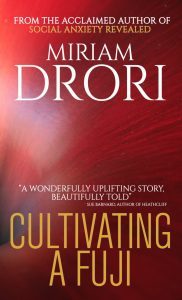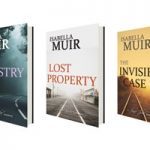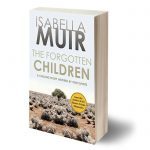Sandy J Cee's Blog, page 2
November 10, 2021
Hello world!
Welcome to gregsshowcase.com.au Sites. This is your first post. Edit or delete it, then start writing!
August 5, 2021
How to outline your novel
May 31, 2020
N J Simmonds Writer
July 1, 2019
Miriam Drori – Author of Cultivating a Fuji
“All fiction is largely autobiographical and much autobiography is, of course, fiction.”
So said P.D. James. I couldn’t possibly confirm or deny the statement. But I know the question of whether a novel is autobiographical is one that is often asked, by interviewers as well as by family, friends and casual acquaintances.
Why do we authors sometimes feel vexed by the question? I think we’re bothered and maybe a little insulted by the suggestion that we’ve inserted a piece of ourselves rather than being totally creative. And yet, we probably all do it to some extent. Putting yourself into another’s shoes can be awfully hard. Why not let your character have just a few of your own experiences, thoughts and feelings?
Of course, that leaves us wide open to the question, “How autobiographical is the novel?” Inside, there’s a feeling that any declaration of similarity between the main character and ourselves is an admission that we took the easy way out. But how valid a feeling is that?
In some ways, it is true. It lets us write about things we’ve always known, which must be easier than making it all up from scratch. In other ways, it’s much harder than writing about a totally fictional character, or at least one that isn’t you. It bares you, the author, making you vulnerable to criticism and taunting.
I’m going to tell you the story of the first character I ever created. I’d spent a few years as a member of an online forum for sufferers of social anxiety, where I learned a lot through reading their posts and comments. I’d written a non-fiction book explaining social anxiety, which included numerous quotes from fellow sufferers. (That book, Social Anxiety Revealed, was published in an improved version years later.) I’d decided I wanted to delve into fiction, because fiction could free me to write about thoughts and feelings that no real people would admit to. I’d read several excellent books about writing fiction.
Who would my main character be? One of the decisions I made early on was that my main character would be male. This was in order to distance him from me. The main character would have similar traits and experiences to me, including being bullied at school, but because he was male, the bullying would be much more physical. Because he was male, he could go though life without anyone ever approaching him to begin a romantic relationship. Because he was male, he clearly wouldn’t be me.
The novel also had a female protagonist, but her path to social anxiety was completely different to mine.
So, I wrote my novel, filling pages of notebooks with my scribbles. Lacking names for my main characters, I called them M for male and F for female, and they eventually morphed into Martin and Fiona. I gave Martin some of my experiences, not really believing I was able to make up whole scenes, but eventually I learned to be more creative. I worked on my novel with the writing group I joined. I submitted it to a ‘real author’, who charged a fee for critiquing. When the critique arrived, I discarded the novel, realising the plot wasn’t interesting enough. Really, it didn’t have much of a plot at all. Looking back now, I wonder how I could ever have thought it had any merit at all.
I went on to write other fiction, unconnected to social anxiety, and, in due course, I began to get published. But I didn’t forget Martin and Fiona, and I’m delighted they’re back in my new novel, Cultivating a Fuji. Delighted but also nervous, because that question will undoubtedly return often and I need to answer it without showing a hint of frustration: “Yes, there are similarities between Martin and me, but there are also differences. Martin has different genes and different experiences that combine to make him a different person. He believes the best way for him to live his life is alone, keeping apart from other people as much as possible. That was never my philosophy. I always craved company, no matter what it did to me.”
What I shouldn’t say to the questioner is, “No, Martin isn’t me! He’s totally made up.” That would make me sound angry, and the falsity of such an answer, while probably delighting an interviewer trying to galvanise the audience, wouldn’t show the best side of me!
I think it’s all right for a novel to be partly autobiographical. I think it’s natural for authors to be drawn to topics that have affected them personally, and to create characters who have something in common with the authors themselves. In my case, I became passionate, years ago, about raising awareness of social anxiety through being a member of that online forum. I realised how a lot of people would be helped if there were more knowledge, understanding and even compassion in the wider community. That’s why I knew I wanted to write about it. And any character with social anxiety that I created would have to share some traits with me.
Like all interview questions, preparation is essential, especially when you’re as unspontaneous a person as I am. I think I’ve got the autobiographical one worked out, now, thanks to you, Sandy.

Miriam Drori can be found on Facebook, Twitter, Goodreads, Pinterest, Instagram, Wattpad and on her website/blog and social anxiety blog.
Miriam Drori is the author of the following Books:
The Women Friends: Selina (With Author Emma Rose Miller)
Cultivating a Fuji – What’s Social Anxiety Really Like?
Amazon page: Author.to/MiriamDroriAtAmazon.
June 30, 2019
Isabella Muir – Author of the Sussex Crime Mysteries
I had written my first novel. That in itself was a milestone. But I was soon to discover that it was just the first milestone on my journey to becoming an independent author.
Along the way, at each T-junction and crossroads there have been decisions to make. It is only now, some four years on, that I can see the route map that has led me to where I am now – a contented author of four novels, two novellas and a short story anthology.
Looking back to the first few steps on my journey I appreciate that the critical decisions I made early on are the ones that I have repeated throughout, in different guises.
Once I had completed my first manuscript – even before I decided whether or not to approach a literary agent – I needed feedback. Did the story hold up, what about the characters and setting? Having completed my MA in Professional Writing with Falmouth University in 2015, I was fortunate to remain in contact with two wonderful emerging writers. Christoffer Petersen, whose chosen genre is Arctic noir – thrillers and crime – and Sarah Acton, who excels in the field of poetry and nature writing. Both were happy to work on my manuscript to provide advice and guidance by way of structural and content editing. Having been a technical editor for all my working life, I felt confident enough to undertake the copy edit and proof-reading myself. These early stages are vital, whether someone chooses to pitch to an agent or prefers to independently publish. No reader wants to read a story full of plot gaps or grammatical errors.
Perhaps it was this ongoing connection with Christoffer Petersen (who had already successfully chosen the indie route) that led me to follow in his footsteps, or perhaps I was in a hurry to see my novel in print. Choosing to break into the traditional world of publishing requires persistence and patience; it can be months, even years, before an author is accepted by an agent and the book is then accepted by a publisher. Once the contract is agreed it can take many more months while the manuscript goes through the editing and production stages and finally lands on a bookshop shelf. If I had chosen this route it would also mean I would need to relinquish control. As someone who has run my own company for the last thirty years I’m not great at being told what to do! The indie route meant I had control over every element of my novel: the title; the cover; the formatting, the pricing and the sales outlets.
Of course, it also meant I had another set of skills to learn and many more decisions to make. Throughout my journey I have gathered some wonderful supporters. I joined a local group of independent authors (CHINDI) each with their own chosen route to publishing. Some have followed a similar path to me, doing much of the preparatory work themselves; others have enlisted the paid help of individuals or organisations to edit and format their text, design their covers and upload their novels to the popular outlets.
I have always loved the concept of bartering. Each of us has skills that may prove valuable to others. I am so grateful for the chance to be able to ‘trade’ expertise with Chris. He creates all my design and artwork, for covers and marketing materials, and I edit his thrillers. It works well for both of us and I am sure will continue to prove an invaluable partnership.
I chose to use KDP, which is the independent publishing arm of Amazon, with your titles being automatically made available for sale in twelve different Amazon marketplaces worldwide. Although the website is fairly hand-holding, I needed to learn about categories and tags and pricing. Amazon offers 60% royalties on sales of paperbacks and a choice of 35% or 70% royalties for ebooks (depending on your sales price).
Like any professional area there is some jargon associated with indie publishing. I learned what it means to ‘go wide’, which is effectively deciding to publish on other platforms as well as Amazon. There are many, including Kobo, Smashwords and Apple iBooks. I also discovered that by uploading to Ingram Spark I had more chance of getting my novels into bookshops.
Once the books ‘exist’ in both paperback and ebook form, the next challenge is to let readers know about them! Now a fresh set of skills is needed – marketing and promotion. There are many routes, some paid, some unpaid. Of course, there is paid advertising, but social media is useful and free, although it is not enough to plead with people in tweets and Facebook posts to ‘please buy my book’. Millions of other authors are hoping for the same thing. Joining topic-specific Facebook groups can prove helpful, not least because it means you are widening your support network. I have been involved in several blog tours whereby interested individuals receive a free book, in return for an unbiased review. Having reviews on sites such as Amazon can help readers decide whether or not to purchase a book. Remember, there is always the risk the reviews may not be favourable, but then as an author you need to be ready for criticism as well as praise! Via the CHINDI network I have been involved in various summer fetes and festivals where I have had the chance to sell my books directly to the public. I have also donated copies to my local library. In recent months I have gone on to organise audiobook versions of two of my novels, which has been really interesting and worth considering, as the audiobook format is a significant growth area among the reading public.
Throughout my journey I have come to rely on many different ‘resources’, among them my own set of developing skills and my increasing network of supporters. The resource of time is, of course, also an issue. Being an indie author is like running your own business. In addition to the elements I have mentioned above, you need to set your own deadlines, monitor sales and keep a basic set of accounts. All authors know the challenge of juggling time; there are so many distractions and never enough hours in the day for writing. As an indie author, there is a whole other set of tasks to draw you away from that notebook.
It is also worth reflecting on your motivation for writing. Whether you choose the independent route, or opt to seek out a traditional publishing deal, it is unlikely to result in you making a million! After all, there is only one JK Rowling! However, I do know indie authors who are able to earn enough to make it their full-time occupation, but like most things in life, such success comes from a mixture of hard work and good luck. Choosing a niche genre can help, as well as being prepared to be quite vocal in terms of marketing and promotion.
The route to publication can be complicated and challenging, but for me – in the main – it has been joyful. I have only provided a snapshot here, but hopefully it is a useful ‘taster’ to tempt you to find out more.


Isabella Muir is the author of the Sussex Crime Mystery series:
BOOK 1: THE TAPESTRY BAG
BOOK 2: LOST PROPERTY
BOOK 3: THE INVISIBLE CASE
And her latest novel is: THE FORGOTTEN CHILDREN
She can be contacted via:
Twitter: @SussexMysteries
Facebook: www.facebook.com/IsabellaMuirAuthor/
Website: www.isabellamuir.com
Or on Goodreads
June 15, 2019
G. R. Lyons
While daylighting as office manager for the family auto repair business, G.R. Lyons can often be found working on one of multiple manuscripts or desperately trying to keep up with the TBR pile.
Anarcho-capitalist, quietly ‘out’ trans guy, former belly dancer, coffee guzzler, highly-sensitive introvert, CrossFit enthusiast, and lover of m/m romantic fiction.
June 14, 2019
Ang B.
Ang B grew up on a Smallholding, just outside of Cape Town, South Africa. She is the youngest of 3.
They all had typical daily farm life allowing her to understood the importance of preparation, hard work, and respect. She applied these values to her daily endeavors by making an inventory of resources, planning her activities, executing efficiency and working daily on her goals.
It’s always been her dream to write a novel and discover the link that connects people. The goal is to create a story that people can connect and relate to.
She loves hiking and going on coffee dates, when she isn’t glued to the computer screen.
She currently resides in beautiful Cape Town, South Africa with her husband.
You can follow her on Instagram: @ang_b_writing
Eva Pasco
“On the road, as in life–I accelerate!”
A Jill-of-all-Trades in the progression of life–a factory fatale gluing eyes on pairs of lion slippers at Capitol Heel Lining, collating booklets at Sidney-Higgins Bookbinding, getting downright dirty at H & H Screw Products, and teaching in the third-grade classroom trenches–Eva Pasco turned a corner after retirement.
Reviving a dormant flair for writing, she braved the arduous journey along the Indie author’s untrammeled path, a route chosen to bypass literary agents and take full control of the publication process from cover to copy through the genre of Contemporary Women’s Fiction–‘Underlying Notes,’ ‘An Enlightening Quiche,’ and the novella, ‘Mr. Wizardo’.
Unsolicited by the author, TIME news reporter, Jeninne Lee-St. John, conducted a telephone interview, delving into the driving force behind Eva Pasco’s debut novel, UNDERLYING NOTES, shortly after its first printing. (March 17, 2008 print issue): “Scents and Scentsitivity”: “She calls herself a “fragrance floozy,” but she’s no eccentric kook.”
Ms. Pasco has also composed numerous Retro 60s Flashbacks, and a slew of essays pertaining to her native state of Rhode Island prefaced with “Rhode Read”. She also writes a weekly blog related to writing and social marketing. All of her literary works can be viewed on her web page at Authors Den
Steve Harrison
In 1795 a convict ship leaves England for New South Wales in Australia. Nearing its destination, it encounters a savage storm but, miraculously, their battered ship stays afloat and limps into Sydney Harbour. Here, the convicts rebel, overpower the crew and make their escape, destroying the ship in the process. Fleeing the sinking vessel with only the clothes on their backs, the survivors struggle ashore.
Among the escaped convicts, seething resentments fuel an appetite for brutal revenge against their former captors while, for their part, the crew attempts to track down and kill or recapture the escapees. However, it soon becomes apparent that both convicts and crew have more to concern them than shipwreck and a ruthless fight for survival; they have arrived in Sydney in 2017.
TimeStorm is a thrilling epic adventure story of revenge, survival and honour set in a strange new world of unfamiliar technology and equally unfathomable social norms. In the literary footsteps of Hornblower, comes Lieutenant Christopher ‘Kit’ Blaney, an old-fashioned hero, a man of honour, duty and principle, dragged into the 21st century… literally.
A great fan of the grand seafaring adventure fiction of CS Forester, Patrick O’Brien and Alexander Kent, and modern action thriller writers such as Lee Child, Steve Harrison combines several genres in his debut novel.
The book was inspired by a replica 18th century sailing ship on Sydney Harbour and a question from Steve’s brother, Tony: “What if that was a real convict ship?” TimeStorm explores that question in a fast-paced story as a group of desperate men from the 1700s clash in modern-day Sydney.
TimeStorm was Highly Commended in the 2013 Jim Hamilton Award fantasy/science fiction category of the Fellowship of Australian Writers (FAW) National Literary Awards



